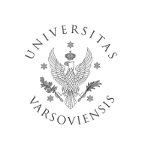
The aim of LSSCB (Chemical and Biological Systems Simulation Lab) is to develop and apply theoretical and computational methods (ranging from quantum chemistry to molecular mechanics/dynamics) to describe the chemical, physical and biological phenomena. The particular focus of the lab is on the prediction of protein structures, nanotechnology, homogeneous catalysis and physical organic chemistry.
We are interested both in basic research as well as its applications to help solve real industrial problems. LCCSB is affiliated with the Centre of New Technologies, University of Warsaw.
Please visit our Group Website for more details.

phone: +48 22 55 43671
room: 04.59
Degrees: MSc (Chemistry), PhD (Chemistry), DSc (Habilitation, Chemistry)
Tel: (+48) 554 36 71 Fax: (+4822) 554 08 01
Email: b.trzaskowski@dev.dev.cent.uw.edu.pl/en
Affiliation: Center of New Technologies, University of Warsaw, Poland
Research Interests:
Bartosz Trzaskowski interests are focused on the development and use of computational methods for the description of chemical, physical and biological phenomena. Currently he is involved mainly in projects related to homogenous catalysis with the aim to better understand the mechanisms of actions of catalysts and use this knowledge to design new, better catalysts for important chemical reactions. Earlier his main research area was the development and coding of new protocols for the prediction of the 3-dimensional, all-atom structure of G protein-coupled receptors (GPCRs). Most of his work in this topic was related to the CCR5 receptor which is used by HIV to enter target cells. He is an expert in modeling the structures of other chemokine receptors, their activation mechanisms and rational drug design and development. He is also interested in material science and combining biological systems with inorganic/organic ones to design and produce novel materials.
Research Summary (Past & Current):
Head of the Chemical and Biological Systems Simulation Laboratory.
His main expertise covers computational chemistry, biochemistry, biology, materials science and drug design. He is actively performing atomic scale simulations, applying computational models to solve problems in various fields of science and developing computational algorithms. His recent achievements cover the thorough mechanistic description of catalytic processes related to olefin metathesis.
He received an MS degree in Computational Chemistry (Faculty of Chemistry, University of Warsaw) under the supervision of Andrzej Leś in 2001. In 2005 he defended his PhD degree in Computational Chemistry (Faculty of Chemistry, University of Warsaw) under the same supervisor. From 2005 to 2008 he was a postdoctoral researcher at the Department of Chemistry, University of Arizona (Tucson, USA) in Ludwik Adamowicz group. In 2008 he moved for his second postdoctoral researcher position to California Institute of Technology where he worked in William A. Goddard III group at the Department of Chemistry. In 2010 he came back to Poland working for a short time at the International Institute of Molecular and Cell Biology in Warsaw before moving to the Faculty of Chemistry (Sławomir Filipek lab).
From 2013 he is the head of the Chemical and Biological Systems Simulation Laboratory at the Centre of New Technologies. He was also a visiting professor at the University of Arizona in 2013-2014 within the Mobility program.
Education
- MSc: 2001, Faculty of Chemistry, University of Warsaw, Poland. Major: computational chemistry.
Thesis title:
“Octahedral manganese complexes – an introduction to the modeling of inhibitors of the small cell lung cancer”; - PhD: 2005, Faculty of Chemistry, University of Warsaw, Poland.
Major: computational chemistry.
Dissertation title:
„Diffusion of curved surfaces”; - PostDoc: 2005 – 2008, Department of Chemistry, University of Arizona, USA.
Research project: “Electroless Plating of Protein Templates for the Fabrication of Straight Nanowires on Silicon“; - PostDoc: 2008 – 2010, Department of Chemistry, California Institute of Technology, USA
Research project:
“Prediction of Structures and Ligands for GPCRs“; - Habilitation: 2017, Faculty of Chemistry, University of Warsaw, Poland
Major: Chemistry
Dissertation title: “Modelling of structures and reactions paths of ruthenium complexes, potential olefin metathesis catalysts”
Positions held
- 2013 – present – Head of Chemical and Biological Systems Simulation Laboratory, Centre of New Technologies, Warsaw University, Poland.
- 2012 – 2013 – Assistant Professor, Faculty of Chemistry, Warsaw University, Poland.
Visiting Researcher
- 2013 – 2014, Department of Chemistry, University of Arizona, USA
- 2009 – Department of Chemistry, University of Sidney, Australia
- 2003 – 2014, Department of Chemistry, Stockholm University, Sweden
Other professional activities and memberships
- Member of the Polish Chemical Society
Recent major publications
- S. Osella, M. Kiliszek, E. Harputlu, C.G. Unlu, K. Ocakoglu, J. Kargul, B. Trzaskowski, “Controlling the Charge Transfer Flow at the Graphene/Pyrene-Nitrilotriacetic Acid Interface”, J. Mater. Chem. C, 6, 5046-5054 (2018).
- R. Gawin, A. Tracz, M Chwalba, A. Kozakiewicz, B. Trzaskowski, K. Skowerski, “Cyclic Alkyl Amino Carbene Ruthenium Complexes – Unprecedented Efficiency in Macrocyclization and Acrylonitrile Cross Metathesis”, ACS Catal., 7, 5443-5449 (2017).
- K. Grudzień, B. Trzaskowski, M. Smoleń, R. Gajda, K. Woźniak, K. Grela, “Hoveyda-Grubbs catalyst analogues bearing derivatives of N-phenylpyrrol in carbene ligand – structure, stability, activity and unique ruthenium-phenyl interactions”, Dalton Trans., 46, 11790-11799 (2017).
- B. Żyżyńska-Granica, B. Trzaskowski, S. Niewieczerzal, S. Filipek, O. Zegrocka-Stendel, M. Dutkiewicz, P. Krzeczyński, M. Kowalewska, K. Koziak, “Pharmacophore guided discovery of small-molecule interleukin 15 inhibitors”, Eur. J. Med. Chem., 136, 543-547 (2017)
- R. Abrol, B. Trzaskowski, W.A. Goddard, A. Nesterov, I. Olave, C. Irons, “Ligand and mutation induced conformational selection in the CCR5 Chemokine G protein-coupled receptor”, Proc. Natl. Acad. Sci. USA, 111, 13040-13045 (2014).
- J. Bray, R. Abrol, W.A. Goddard, B. Trzaskowski, C. Scott, “The SuperBiHelix Method for Predicting the Pleiotropic Ensemble of G-Protein Coupled Receptor Conformations”, Proc. Natl. Acad. Sci. USA, 111, E72-E78 (2014).
Research projects
- 2018-2020 NCN Beethoven 2 grant “Anionic Carbenes and Borylanions: Tuning the properties of ruthenium metal complexes in olefin metathesis” to B. Trzaskowski, PI;
- 2017-2021 NCN SONATA BIS 6 grant “ Anionic, cationic and mesoionic analogues of N-heterocyclic carbenes in homogenous catalysis” to B. Trzaskowski, PI;
- 2012-2015 NCBiR 3rd Polish-Singaporean competition grant “Green and sustainable catalysts for chemical, agrochemical and pharmaceutical industry” to B. Trzaskowski and K. Grela, coPIs;
- 2013-2015 NCN OPUS 3 grant “New analogues of N-heterocyclic carbenes in Ruthenium-based metathesis catalysts – design, modeling, synthesis, analysis” to B. Trzaskowski, PI;
- 2013-2014 MNiSW Mobility Plus grant “New hybrid materials and biomaterials – design, structure and properties modelling and synthesis” to B. Trzaskowski, PI;
- 2012-2013 Polpharma Scientific Foundation grant “Identification of a new chemical compounds inhibiting biological effects of interleukin 15 (IL-15) via selective blocking of IL-15R receptor”, key personnel
- 2011-2012 National Science Foundation (US) grant “EAGER: Mattressene – A 3D Carbon Nanostructure Superlattice: Experimental and Theoretical Synthesis and Characterization”, key personnel
- 2009-2011 Foundation for Polish Science Homing/Powroty grant “First Principles Predictions of the Structure and Function of Chemokine Receptors” to B. Trzaskowski, PI;
- 2009-2010 Chevron grant “Low-temperature methane-to-methanol oxidation”, key personnel
- 2008-2019 PharmSelex grant “Prediction of Structures and Ligands for GPCRs”, key personnel
- 2005-2008, National Science Foundation (US) NIRT grant “Electroless Plating of Protein Templates for the Fabrication of Straight Nanowires on Silicon”, key personnel
- 2004-2005, Ministry of Science and Higher Education (Poland) grant “Quantum mechanical study of the solvolysis of CMP-NeuAc and its application in modelling of sialyltransferase inhibitors” to B. Trzaskowski, PI;
Teaching experience
- University of Warsaw: Basic Informatics, Advanced Informatics, Quantum Chemistry A, Inorganic Chemistry, General Chemistry, Calculations in Analytical Chemistry
- Warsaw Medical University: Medicinal Chemistry, Biochemistry with elements of chemistry
Awards
- 2012-2015, Stipend for outstanding young scientists, Ministry of Science and Higher Education (Poland)
Languages:
Polish (native), English (fluent)
Bartosz Trzaskowski, PhD
Postdoctoral Fellows:
Magdalena Jawiczuk, PhD
Nirmalya Mukherjee, dr
Silvio Osella, PhD
Anna Rybicka, PhD
PhD students:
Anna Marczyk, MSc
Katarzyna Młodzikowska, MSc
Research Technician:
Magdalena Kurowska
| Title | Project Leader | Project period | Project funding |
|---|---|---|---|
| Anionic, cationic and mesoionic analogues of N-heterocyclic carbenes in homogenous catalysis | Bartosz Trzaskowski | 2017 - 2021 | NCN, SONATA BIS |
| Anionic Carbenes and Borylanions: Tuning the properties of ruthenium metal complexes in olefin metathesis | Bartosz Trzaskowski | 2018 - 2020 | Beethoven, NCN |
| Towards an efficient design of biosensors: an investigation of the interplay between light harvesting proteins and graphene | Silvio Osella | 2016 - 2018 | POLONEZ, NCN |
Młodzikowska, K., Rajkiewicz, A. A., Grela, K., & Trzaskowski, B. (2018).
New Journal of Chemistry.
Jolly, P. I., Marczyk, A., Małecki, P., Ablialimov, O., Trzybiński, D., Woźniak, K., ... & Grela, K. (2018).
Chemistry-A European Journal.
Sidoryk, K., Cmoch, P., Świtalska, M., Trzaskowski, B., Wietrzyk, J., & Cybulski, M. (2018).
Carbohydrate research, 460, 19-28.
Ostrowska, K., Grzeszczuk, D., Głuch-Lutwin, M., Gryboś, A., Siwek, A., Leśniak, A., ... & Trzaskowski, B. (2018).
Bioorganic & medicinal chemistry, 26(2), 527-535.
Osella S*, Kiliszek M, Harputlu E, Unlu CG, Ocakoglu K, Kargul J*, Trzaskowski B (2018)
J. Mater. Chem. C. 6, 5046-5054
Grela, K., Zieliński, A., Szczepaniak, G., Gajda, R., Woźniak, K., Trzaskowski, B., ... & Kajetanowicz, A. (2018)
European Journal of Inorganic Chemistry
Knippenberg, S., Fabre, G., Osella, S., Di Meo, F., Paloncýová, M., Ameloot, M., & Trouillas, P. (2018)
Langmuir
Diez‐Cabanes, V., Gonzalez, S. R., Osella, S., Cornil, D., Van Dyck, C., & Cornil, J. (2018)
Advanced Theory and Simulations, 1(3), 1700020
B. Trzaskowski, K. Ostrowska, (2017)
Catalysis Communications, 2017, 91, 43-47 doi:10.1016/j.catcom.2016.12.014
Trzaskowski, B., W. A. Goddard, and K. Grela, (2017).
Molecular Catalysis 433 (2017): 313-320.
Grudzień, K., Trzaskowski, B., Smoleń, M., Gajda, R., Woźniak, K., & Grela, K. (2017).
Dalton Transactions, 46(35), 11790-11799.
Żyżyńska-Granica, B., Trzaskowski, B., Niewieczerzał, S., Filipek, S., Zegrocka-Stendel, O., Dutkiewicz, M., Krzeczyński, P., Kowalewska, M. and Koziak, K., (2017).
European journal of medicinal chemistry, 136, 543-547.
Ostrowska, K., Grzeszczuk, D., Głuch-Lutwin, M., Gryboś, A., Siwek, A., & Trzaskowski, B. (2017).
MedChemComm, 8(8), 1690-1696.
Trzaskowski, B., & Ostrowska, K. (2016).
RSC Advances 6, no. 26 (2016): 21423-21429.
Trzaskowski, B., Ostrowska, K., & Adamowicz, L. (2016).
Carbon Nanomaterials Sourcebook: Nanoparticles, Nanocapsules, Nanofibers, Nanoporous Structures, and Nanocomposites (pp. 115-139). CRC Press.
Trzaskowski, B., & Grela, K. (2016).
Catalysis Communications, 86, 133-138.
Pazio, A., Woźniak, K., Grela, K., & Trzaskowski, B. (2015)
Dalton Transactions, 44(46), 20021-20026
Pazio, A., Woźniak, K., Grela, K., & Trzaskowski, B. (2015).
Organometallics, 34(3), 563-570.
Abrol, R., Trzaskowski, B., Goddard, W. A., Nesterov, A., Olave, I., & Irons, C. (2014).
Proceedings of the National Academy of Sciences, 111(36), 13040-13045.
Bray, J. K., Abrol, R., Goddard, W. A., Trzaskowski, B., & Scott, C. E. (2014).
Proceedings of the National Academy of Sciences, 111(1), E72-E78.
Trzaskowski, B., Adamowicz, L., Beck, W., Muralidharan, K., & Deymier, P. A. (2014).
Chemical Physics Letters, 595, 6-12.
Romański, J., Trzaskowski, B., & Piątek, P. (2013).
Dalton Transactions, 42(43), 15271-15274.
Trzaskowski, B., Adamowicz, L., Beck, W., Muralidharan, K., & Deymier, P. A. (2013).
The Journal of Physical Chemistry C, 117(38), 19664-19671.
Romański, J., Trzaskowski, B., & Piątek, P. (2013).
Dalton Transactions, 42(43), 15271-15274
| Title | Deadline for applications |
|---|---|
| Postdoc in Chemical and Biological Systems Simulation Laboratory | 30/11/2018 |
| Post-doc to work in the Laboratory of Chemical and Biological Systems Simulation | 24/09/2018 |
| Technician to work in Organometallic Synthesis Laboratory | 13/08/2018 |
| POST-DOC to work in the Laboratory of Chemical and Biological Systems Simulation | 12/08/2018 |


